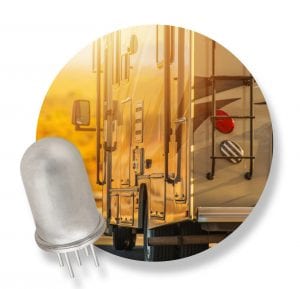Use Case: Custom Tilt Sensor for Hydraulic Leveling Application
The Customer
A large manufacturer of RV leveling and room extension systems was in need of a new high accuracy dual axis tilt sensor for a hydraulic leveling system. They had been using an HL Planar sensor, but the company was bought and that particular part was rendered obsolete.
Hydraulic leveling systems play a key role in RV safety and functionality, giving users the ability to stabilize a parked vehicle on uneven ground at the touch of a button rather than using manual jacks and inaccurate bubble levels. In addition to recreational vehicle applications, hydraulic leveling systems are used to stabilize construction machinery and when lifting, lowering, or leveling permanent structures.
Challenge
Frustrated with the obsolescence of this key sensor, the customer came to Fredericks looking for a replacement with a particularly high resolution and null offset.
Although some applications have seen a shift toward MEMS tilt sensors, electrolytic tilt sensors remain the primary technology used in RV leveling applications because of their long term stability and accuracy. Electrolytic tilt sensors are also considerably more durable. MEMS tilt sensors are extremely sensitive to vibration and tend to wear out quickly, whereas electrolytic tilt sensors have no moving parts and offer long term stability and turn on bias.
Accuracy is the most important performance metric for any tilt sensor, which most manufacturers specify by combining several specifications including, but not limited to, repeatability, drift, linearity, and performance over temperature. Click here to learn more about electrolytic tilt sensors for RV leveling applications.
Solution
The customer was originally interested in one of our standard dual-axis wide-range sensors, the 0717-4319-99, but it needed different performance specs so Fredericks created a custom sensor to meet their requirements. In order to meet those requirements, our engineers made several modifications to the existing 0717-4319-99 including tighten the null offset, increasing the gain/slope of the output, and increasing the resolution of the sensor by using a different fill level of electrolytic fluid. 
Electrolytic Tilt Sensor Basics
There are many different types of tilt sensors, but electrolytic tilt sensors are the most common for RV leveling systems. There are four primary reasons for this:
- Accuracy and repeatability
- Long term stability and turn on bias
- Temperature stability
- Cost
Their wide operating range of ±50° tilt removes any concerns related to mounting and significantly simplifies manufacturing, testing, and installation in an RV for an OEM or end user. Compared to other tilt sensing technology available at the same price, these two tilt sensors provide much better accuracy, down to a tenth of a degree (±0.1°) for the 0717-4319-99 and down to half-a-tenth of a degree (±0.05°) for the 0717-4313-99. This high accuracy is maintained over the life of the sensor and takes into account any turn-on bias (also called null offset or zero drift), which causes significant error in angle readings with many other tilt sensing technologies. The accuracy is also maintained over a wide temperature range which encompasses anything you might normally experience outside or in the cabin of a vehicle in outdoor conditions, from -40° C to 85° C (or -40° F to 185° F).
Why Fredericks?
As a leading expert in tilt measurement solutions, Fredericks often works directly with customers to provide custom solutions for their engineering challenges. In this case, we supported the customer from a design perspective, specifically electrical and software engineering.
We offer economical options that are often priced lower than competitors. In this case, our custom sensor not only met their engineering needs, it also had a lower price tag than the part they had been using before.
Are you looking to replace an obsolete part? This is a headache that engineers and designers face on a regular basis, but at Fredericks we’re proud to say that we don’t obsolete parts as long as customers are using them. Fredericks has been manufacturing tilt sensors and inclinometers for over 80 years and we’re excited to bring new and innovative tilt solutions in the years to come.
For more information about products and pricing, fill out an online form, call us at +1 (215) 947 2500, or email us at sales@llamastage.com.





